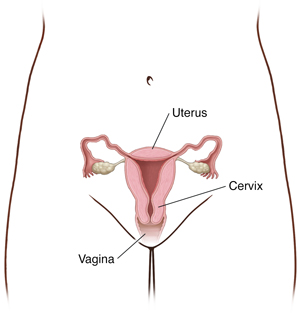Understanding Endocervical Curettage
Endocervical curettage is when the healthcare provider takes some tissue from inside your cervix. This tissue is sent to a lab. It is checked for any problems, such as cancer.
The cervix is the narrow, lower part of your uterus. It opens up into your vagina. The length of the cervix is called the cervical canal.

How to say it
ehn-doh-SER-vih-kuhl kuhr-ruh-TAHZH
Why endocervical curettage is done
You may need this done if you have abnormal bleeding from your uterus. It can help find out the cause. It may be done as part of the evaluation done for an abnormal Pap test. It may also be done to remove growths (polyps) or other reasons for the bleeding.
How endocervical curettage is done
You can have this done in a hospital. Or it may be done at an outpatient facility. During the procedure:
-
You may be given medicine so you don’t feel pain. You may be awake or asleep.
-
The healthcare provider puts a tool called a speculum into your vagina. It helps them see your cervix better.
-
The provider cleans the cervix with a special solution.
-
The provider uses a tool called a tenaculum to grasp the cervix. It holds the cervix in place.
-
The provider puts a tool called a curette into the cervical canal.
-
The provider gently scrapes a thin layer of tissue from the wall of the cervical canal.
-
The tissue sample is removed and put on a cotton pad or into a small jar filled with preservative solution. The sample is sent to a lab to test for any problems, such as cancer.
Risks of endocervical curettage
-
Bleeding
-
Infection
-
Injury to the cervix
-
Pain and cramping
-
Tear in the uterus
© 2000-2024 The StayWell Company, LLC. All rights reserved. This information is not intended as a substitute for professional medical care. Always follow your healthcare professional's instructions.